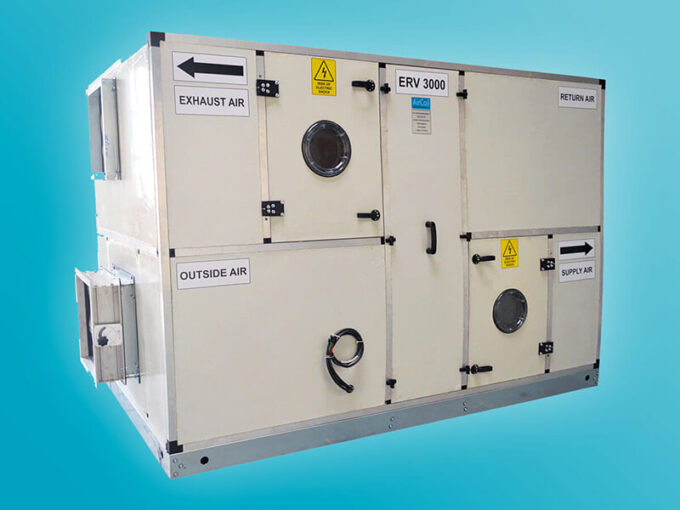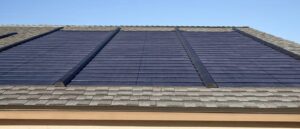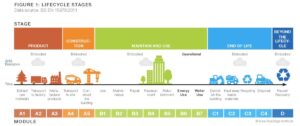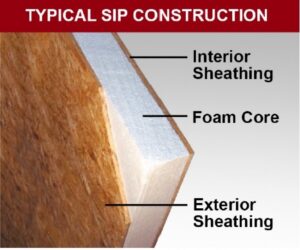In HVAC (Heating, Ventilation, and Air Conditioning) design, understanding ERV vs. HRV (Energy Recovery Ventilators vs. Heat Recovery Ventilators) is crucial. Both systems improve indoor air quality and energy efficiency by exchanging stale indoor air with fresh outdoor air. However, their methods and applications differ significantly.
Basics of ERV and HRV Systems
HRVs are designed to transfer heat between incoming and outgoing air streams. In winter, they preheat the cold incoming air with the warmth of the exhaust air, reducing heating demands. Conversely, in summer, they help cool the incoming air by transferring heat to the outgoing air.
ERVs function similarly but add the capability to transfer moisture. They balance humidity levels by transferring water vapor between the air streams. Therefore, this added function makes ERVs ideal for areas with extreme humidity levels, as they can help maintain comfortable indoor humidity levels year-round.

How ERV and HRV Systems Work
Both ERV and HRV systems use a heat exchanger core to facilitate energy transfer between the air streams.
- HRV Operation:
- Stale indoor air is exhausted outside.
- Fresh outdoor air is drawn inside.
- The heat exchanger transfers heat from the outgoing air to the incoming air.
- ERV Operation:
- Stale indoor air is exhausted outside.
- Fresh outdoor air is drawn inside.
- The heat exchanger transfers heat and moisture between the outgoing and incoming air streams.
Choosing Between ERV and HRV
The choice between ERV and HRV depends on several factors:
- Climate:
- HRV: Best for colder climates where controlling humidity is less critical.
- ERV: Ideal for hot, humid climates or very dry climates to maintain indoor humidity levels.
- Building Type:
- Residential buildings in humid climates benefit from ERVs to prevent excess moisture.
- Commercial buildings with high occupancy may need HRVs to efficiently manage heat without affecting humidity.
Role of Mechanical Engineering Teams
An experienced mechanical engineering team can help evaluate ERV and HRV options. For example, they consider factors such as climate, building design, occupancy, and energy efficiency goals.
Steps an Engineering Team Takes:
- Site Assessment: Evaluating the specific needs of the building and local climate.
- Energy Modeling: Using software to simulate the building’s energy performance with different systems.
- Code Compliance: Ensuring the design meets local and national code requirements.
Code Regulations
Both ERV and HRV systems must comply with standards set by organizations such as ASHRAE (American Society of Heating, Refrigerating and Air-Conditioning Engineers).
Key Standards:
- ASHRAE Standard 62.1: Ventilation for Acceptable Indoor Air Quality.
- ASHRAE Standard 90.1: Energy Standard for Buildings Except Low-Rise Residential Buildings.
Examples of Applications
- Cold Climate Example:
- A school in Minnesota installs an HRV system to manage winter heating loads efficiently.
- Humid Climate Example:
- An office building in Florida uses an ERV to maintain comfortable humidity levels and reduce cooling costs.
Conclusion
ERV and HRV systems are vital in modern HVAC design for improving indoor air quality and energy efficiency. However, choosing the right system requires understanding the climate, building type, and specific needs. Mechanical engineering teams play a critical role in evaluating options and ensuring compliance with relevant codes and standards. Whether it’s an HRV for a cold climate or an ERV for a humid environment, these systems contribute significantly to sustainable and comfortable building design.
By understanding the differences between ERVs and HRVs and knowing when to use each, you can make informed decisions that enhance comfort, save energy, and meet regulatory standards. For more information on HVAC system design and compliance, refer to ASHRAE standards and consult with experienced mechanical engineers. Or reach our to our team of experts at EVstudio for assistance in evaluating systems and designing the best solution for your project.










